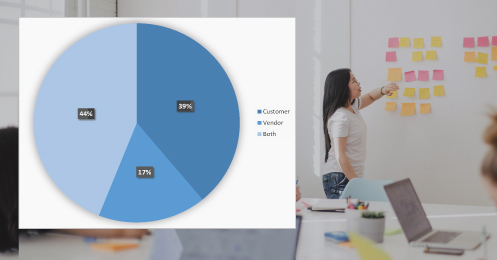Nearly 50% of ERP implementations fail the first time around. Why do you think that is? Maybe it’s a lack of communication between Customer and Vendor or maybe either or both parties didn’t realize the extent of the work needed to be done for a successful implementation. 10 years ago, we posed the question in an ERP LinkedIn Group “Who’s Responsible for Successful ERP Software Implementations? Customer or Vendor?” Good arguments were made for both parties, but the overall consensus was that both should be held responsible.
Here’s a quick summary of the arguments made from the respondents back in 2012:
Vendors (17%) – Vendors are responsible for ensuring the right expectation level based on the customer willingness or ability to be available during the implementation process.
Customers (39%) – The customer is paying the bills and is therefore responsible.
Both (44%) – The vendor and customer must work together.
Our Opinion
Our opinion has not changed over the past 10 years. Our stance has always and will always be that the Vendor and Customer must work together in order to achieve a successful ERP implementation. In the world of ERP, professional vendors have the responsibility to ensure they understand what the Customers’ needs are and to provide them with the guidance in their implementation-related tasks. The Customer is responsible for educating the Vendor on all their needs and business processes upfront. The Customer also has to ensure the right people (decision-makers) are made available during the implementation project. Implementations are rarely straightforward, and no single implementation is going to look exactly like another, so preparation and support on both sides is necessary. A good starting point for Vendors and Customer’s to prepare for a successful implementation is through analyzing current data and getting employees on board with change.
Change Management
ERP implementations are thorough and will require all employees to be on board with the change. Employees should prepare and be open to training on the new system and possibly new processes. If you’ve been using a legacy system for 20 years, your long-term employees may not be as receptive to the change of software as you might think. While the new ERP software will undoubtedly help their everyday tasks, a lot of people dread training and having to take the time out of their workday to learn a whole new system. Remind your employees how ERP software can actually make their jobs easier if used efficiently.
Data
The state of your data before implementation is going to affect how successful the overall implementation goes. When moving from introductory software to an ERP system, a customer can benefit from spending the time and checking that valid data is in the correct fields and duplicate data is removed. Especially if you have multiple solutions, removing bad data ensures the vendor can migrate the clean data over successfully. Remember, the Customer is responsible for educating the Vendor on all business processes up front while the Vendor on the other hand is responsible for using that information to provide a seamless implementation experience.
Other Things to Consider: Deployment
If you implemented software 10 years ago, you may have gone the on-premises route meaning hardware is stored directly on-site where your IT team manages the servers themselves. In recent years, you may have heard of the Cloud or SaaS (Software as a Service) as a deployment method whereby a client accesses the system off-premises via the internet and pays an on-going monthly fee. With Cloud software, you have access to expert support without the need for an in-house IT Team and it means once you switch over, you don’t need to worry about the security of your data (that’s for your Vendor to worry about) leaving you with extra time to focus on more important tasks. A successful ERP Implementation means successfully storing your information and data in the Cloud, allowing you and your customers to conduct business, worry free.










